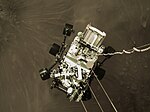3361 Orpheus
| Discovery | |
|---|---|
| Discovered by | Carlos Torres |
| Discovery site | Cerro El Roble |
| Discovery date | 24 April 1982 |
| Designations | |
MPC designation | (3361) Orpheus |
| Pronunciation | /ˈɔːrfiːəs, ˈɔːrfjuːs/ |
Named after | Ὀρϕεύς Orpheus |
Alternative designations | 1982 HR |
Minor planet category | PHA[1] |
| Adjectives | Orphean (Orphæan) /ɔːrˈfiːən/[2] |
| Orbital characteristics[1] | |
| Epoch 13 June 2008 (JD 2454630.5) | |
| Uncertainty parameter 0 | |
| Observation arc | 11752 days (32.18 yr) |
| Aphelion | 1.5999 AU (239.34 Gm) |
| Perihelion | 0.81893 AU (122.510 Gm) |
| 1.2094 AU (180.92 Gm) | |
| Eccentricity | 0.32288 |
| 1.33 yr (485.82 d) | |
| 283.408° | |
| 0° 44m 27.636s / day | |
| Inclination | 2.6849° |
| 189.602° | |
| 301.651° | |
| Earth MOID | 0.0139175 AU (2.08203 Gm) |
| Physical characteristics | |
| Dimensions | 0.3 km[1] |
Mean radius | 0.15 km |
Synodic rotation period | 3.532 h (0.1472 d)[1] |
Absolute magnitude (H) | 19.03[1] |
3361 Orpheus (1982 HR) is an Apollo asteroid that was discovered on 24 April 1982 by Carlos Torres at Cerro El Roble Astronomical Station. Its eccentric orbit crosses that of Mars and Earth, and approaches Venus as well. From 1900 to 2100 it passes closer than 30 Gm to Venus 11, Earth 33, and Mars 14 times. It passed by Earth at a distance of about 0.03 AU (4.5 million km; 12 LD) in 1937, 1978, 1982, and 2021 and will again in 2025.[1]
3361 Orpheus is a potentially hazardous asteroid (PHA) because its minimum orbit intersection distance (MOID) is less than 0.05 AU (7.5 million km; 19 LD) and its diameter is greater than 140 meters. The Earth-MOID is 0.0139 AU (2,080,000 km; 1,290,000 mi).[1] With an observation arc of 36 years, the orbit is well-determined for the next several hundred years.
The orbital solution includes non-gravitational forces.[1]
| Date | JPL SBDB nominal geocentric distance |
uncertainty region (3-sigma) |
|---|---|---|
| 2021-11-21 | 5768611 km | ± 18 km |
| 2198-04-16 | 3908472 km | ± 116 km |
Missions[]

3361 Orpheus had been one of the originally proposed targets for the Near Earth Asteroid Rendezvous (NEAR) mission.
The proposed AIDA mission's spacecraft, Double Asteroid Redirection Test was a fly-by observation of 3361 Orpheus during its trajectory to asteroid 65803 Didymos but later cancelled.[3]
References[]
- ^ a b c d e f g h i "JPL Small-Body Database Browser: 3361 Orpheus (1982 HR)" (last observation: 17 November 2021). Jet Propulsion Laboratory. Retrieved 20 November 2021.
- ^ "Orphean". Oxford English Dictionary (Online ed.). Oxford University Press. (Subscription or participating institution membership required.)
- ^ A.F. Cheng et al., "Asteroid Impact & Deflection Assessment mission: Kinetic impactor," Planetary and Space Science (Available online 4 January 2016)
External links[]
- 3361 Orpheus at NeoDyS-2, Near Earth Objects—Dynamic Site
- Ephemeris · Obs prediction · Orbital info · MOID · Proper elements · Obs info · Close · Physical info · NEOCC
- 3361 Orpheus at ESA–space situational awareness
- 3361 Orpheus at the JPL Small-Body Database

- Minor planet object articles (numbered)
- Apollo asteroids
- Potentially hazardous asteroids
- Discoveries by Carlos Torres (astronomer)
- Minor planets named from Greek mythology
- Named minor planets
- Minor planets to be visited by spacecraft
- Near-Earth objects in 2013
- Near-Earth objects in 2021
- Astronomical objects discovered in 1982





